Tara Tarini Temple Adi Shakti Odisha
Tara Tarini Temple is a Hindu shrine of Adi Shakti in the Kumari hills on the bank of Rushikulya river near Purushottampur in Ganjam district of Odisha, around 28km from Brahmapur city. Maa Tara Tarini is worshipped as the Breast Shrine (Sthana Peetha) of Adi Shakti Sati Devi there.
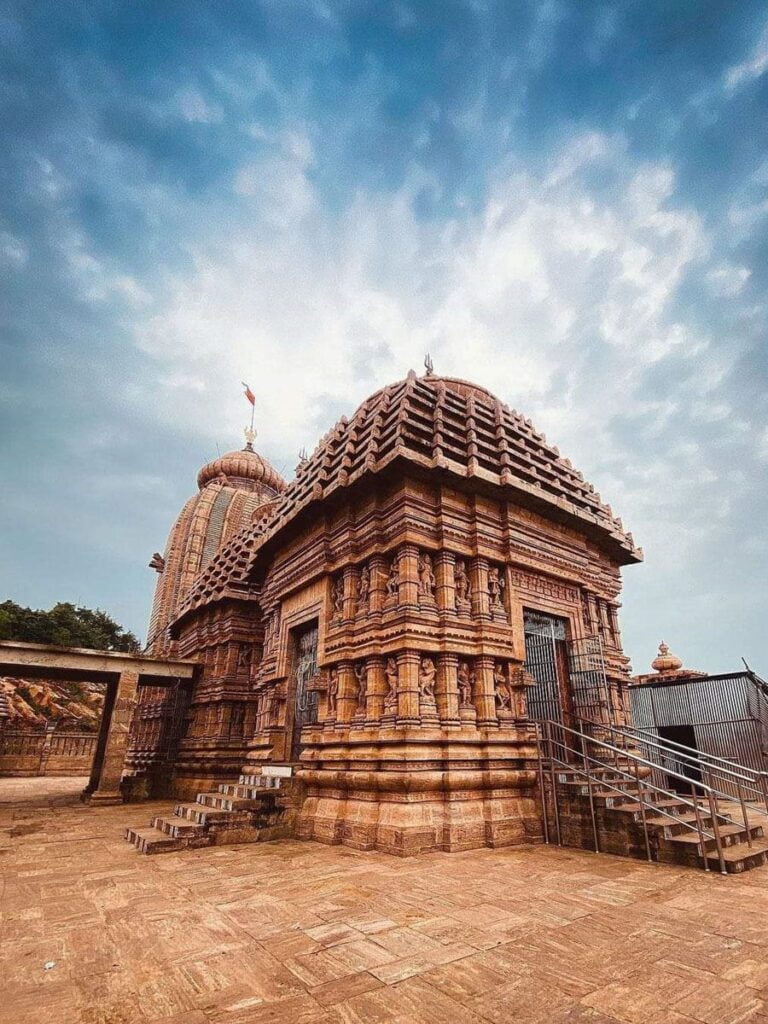
Contents
Tara Tarini Temple History:
Mythological Origins:
Hindu legend links the temple’s origin to the Daksha Yajña, a sacrificial ritual where Sati, the consort of Lord Shiva, immolated herself in protest of her father’s insult. According to the legend, her body parts fell at various locations across the Indian subcontinent, becoming revered Shakti Peethas. The Taratarini Temple is believed to be the “Sthana Peetha,” where Sati’s breasts fell.
Ancient Legacy:
While the exact timeframe of its construction remains debated, the temple’s history is believed to date back centuries. Some sources attribute its origins to the 8th century, while others point to the 11th century under the reign of King Anangabhima III of the Eastern Ganga dynasty. Over the years, the temple has undergone renovations and expansions, particularly under the patronage of the Gajapati kings of Puri in the 19th century.
Read More>> 64 Chausath Yogini Temple Hirapur Odisha
Legend of Tara Tarini Temple:
1. The Divine Sisters:
This legend speaks of two celestial sisters, Tara and Tarini, who manifested on Earth to grant blessings and protection. They took human forms and lived among devotees, performing miracles and guiding them with divine wisdom. They resided in the hills near the temple, leaving footprints on a rock as proof of their presence. Vasu Praharaja, a learned Brahmin, became their foster father and through divine guidance, established a shrine for their worship on the hilltop. The two stone faces adorned with gold and silver in the temple’s sanctum sanctorum are believed to represent these divine sisters.
2. The Blessing of Goddess Durga:
Another legend connects the temple to the epic Ramayana. During his quest to rescue Sita, Lord Rama reached this region and sought the help of Goddess Durga. The goddess appeared to him, instructing him not to look back as she manifested. However, Rama, overcome by curiosity, glanced back, causing the goddess to solidify into a stone idol. She assured him of future aid and instructed him to worship her again in due time. Later, a king named Bhanja found the idol in Puri and desired to take it back to his kingdom. The goddess agreed, on the condition that he never looked back during their journey. As they neared the Baitarini river, Bhanja, worried about the goddess’s silence, peeked back, causing the idol to stop. This spot, near the present-day temple, became the chosen site for her abode.
Read More>> Konark Sun Temple 13th Century Gem
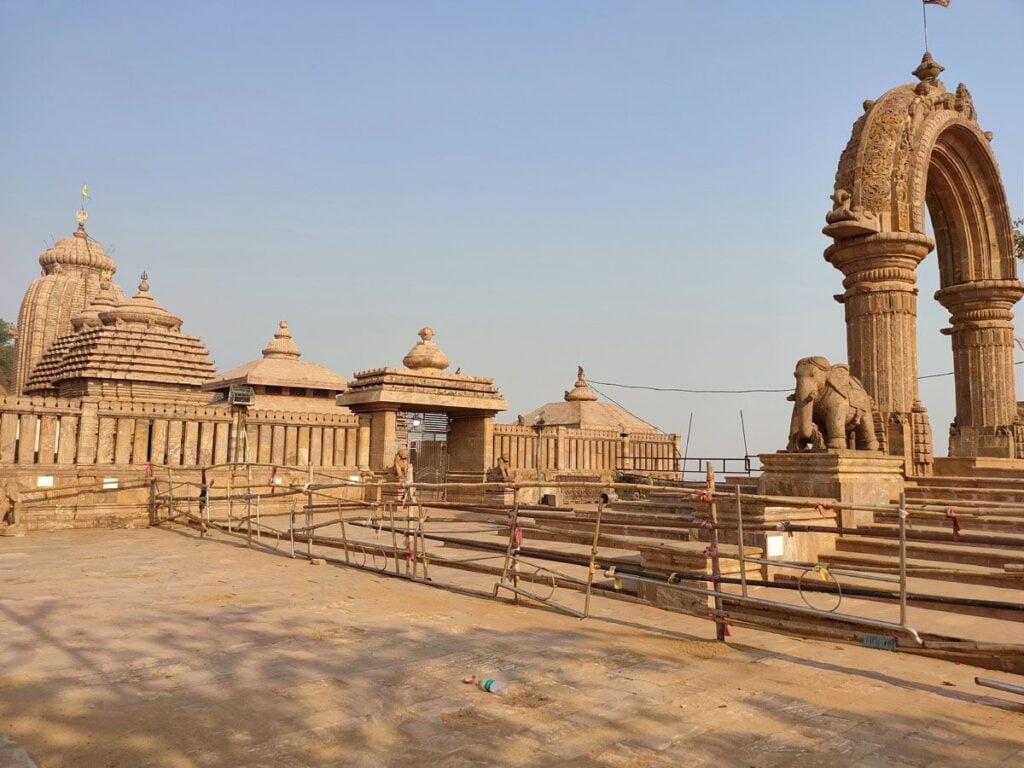
Myths of Tara Tarini Temple:
The Saga of Sati’s Dismembered Body:
One of the most prominent myths surrounding the temple traces its origin to the epic tale of Sati, consort of Lord Shiva. Legend has it that Sati, aggrieved by her father’s insult to Shiva, immolated herself in the sacrificial fire. Enraged by his wife’s demise, Shiva embarked on a destructive dance, carrying her lifeless body across the cosmos. To prevent the world’s annihilation, Lord Vishnu intervened, dismembering Sati’s body with his Sudarshana Chakra. Each of her body parts fell upon different locations, transforming into revered Shakti Peethas. It is believed that Tara Tarini’s abode marks the spot where Sati’s breasts landed, earning it the epithet “Sthana Peetha” – the Breast Shrine.
The Celestial Twins Tara and Tarini:
Another captivating myth speaks of two celestial twins, Tara and Tarini, who descended from the heavens to bless the Kumari hills. These benevolent goddesses lived amongst the locals, performing miracles and granting wishes. Eventually, they bestowed their divine power upon two young girls, transforming them into their earthly vessels. These girls, later known as Maa Tara and Maa Tarini, became the living embodiments of the celestial twins, worshipped with unwavering devotion.
The Pious Fisherman and the Divine Lotus:
A folktale whispers of a pious fisherman named Basu Praharaj, who diligently worshipped the goddesses. One day, while casting his net in the Rushikulya river, he retrieved a magnificent lotus. Entranced by its celestial fragrance, Basu placed the lotus on his head and carried it home. To his astonishment, the lotus transformed into a radiant idol, revealing itself as Maa Tara Tarini. Overwhelmed with awe, Basu built a shrine where the idol stood, marking the foundation of the temple that stands today.
Read More>> Biraja Temple Shakti Peeth Jaipur
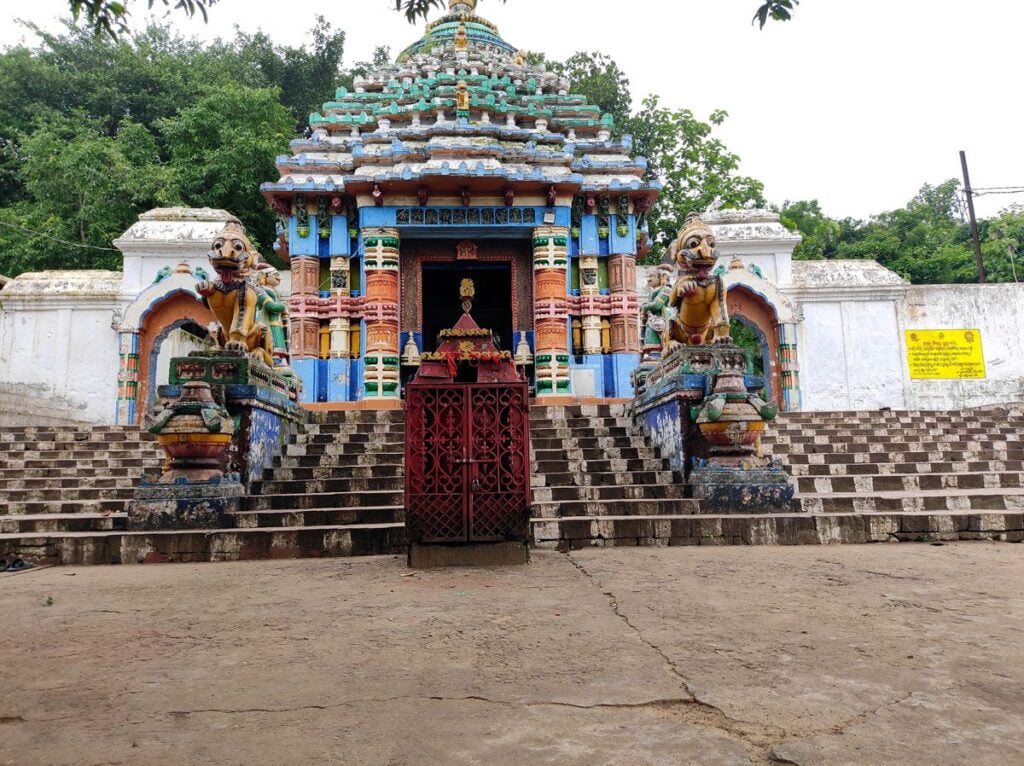
Significance of Tara Tarini Temple:
Religious Significance:
- Shakti Peetha: Tara Tarini is one of the four major Shakti Peethas and Tantra Peethas in India, revered by followers of Shaktism, a Hindu sect worshipping the divine feminine power. These Peethas mark the places where Sati Devi’s body parts fell after her self-immolation, and Tara Tarini is believed to be the “Sthana Peetha,” representing her breasts.
- Twin Goddesses: The temple houses the twin goddesses, Tara and Tarini, considered manifestations of Adi Shakti, the primal cosmic energy. This unique representation symbolizes the duality of creation and destruction, nurturing and fierceness, aspects often associated with the feminine divine.
- Ancient Origins: The temple’s origins remain shrouded in mystery, with estimates placing its existence anywhere between 2nd and 4th centuries CE. Some legends link it to pre-Hindu tribal practices, while others attribute its construction to a Brahmin priest. This adds to its mystique and spiritual allure.
Historical Significance:
- Tantric Tradition: Tara Tarini has been a prominent center of Tantric practices for centuries. Tantric rituals, focusing on harnessing life force energy, are believed to be particularly potent at this site. This association attracts devotees seeking spiritual enlightenment and esoteric knowledge.
- Pilgrimage Site: For centuries, the temple has been a major pilgrimage destination for Hindus across India. Devotees flock here during festivals like Chaitra Mela and Sankranti, seeking blessings and participating in vibrant rituals.
Cultural Significance:
- Odia Identity: Tara Tarini is deeply ingrained in the cultural fabric of Odisha. The twin goddesses are considered the presiding deities of the state, and their image adorns various aspects of Odia life, from art and literature to everyday objects.
- Architectural Marvel: The temple itself is a stunning example of Odia temple architecture, particularly the Rekha Deula style. Its intricate carvings, colorful decorations, and serene atmosphere add to its spiritual charm.
- Empowering Women: The symbolism of the twin goddesses, powerful and independent, resonates with women seeking inspiration and strength. The temple has become a symbol of female empowerment, attracting devotees seeking blessings for success and prosperity.
Beyond religious and cultural significance, Tara Tarini Temple has gained wider recognition in recent years:
- INSV Tarini: The Indian Navy’s sailboat, INSV Tarini, named after the temple, became the first Indian vessel to be circumnavigated by an all-women crew. This feat further cemented the temple’s association with courage and determination.
- UNESCO Tentative List: The temple has been inscribed on the UNESCO Tentative List of World Heritage Sites, highlighting its architectural and cultural importance.
Read More>> Sri Puri Jagannath Temple: The Lord of the Universe
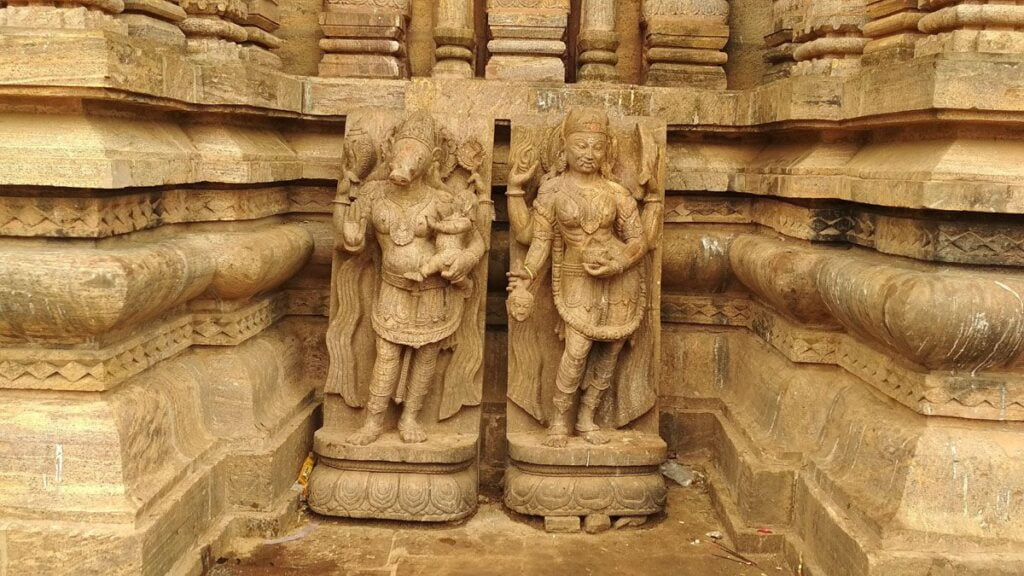
Tara Tarini Temple Timing and Rituals:
Temple Timings:
- Darshan (seeing the deities): 5:00 AM to 11:00 PM (with a few short breaks in between)
- Mangala Aarti (morning offering): 5:00 AM
- Sandhya Aarti (evening offering): 7:00 PM
- Special pujas (worships) are performed throughout the day.
Rituals:
- Darshan: Devotees can offer prayers and view the deities through the sanctum door.
- Abhishek: Offering of sacred water, milk, honey, etc. to the deities.
- Archana: Chanting of hymns and mantras by priests on behalf of devotees.
- Pushpanjali: Offering of flowers to the deities.
- Bhog: Offering of food to the deities, later distributed as prasad.
- Special pujas: Specific rituals performed for various occasions like birthdays, anniversaries, seeking blessings for good health, etc.
Read More>> Tirumala Tirupati Venkateswara Swamy
Places to visit near Tara Tarini Temple:
- Mahuri Kalua:
- Mahuri Kalua is a picturesque spot near Tara Tarini Temple, known for its scenic beauty. It is a tranquil place surrounded by lush greenery, making it ideal for a peaceful retreat.
- Gopalpur-on-Sea:
- Gopalpur-on-Sea is a popular beach destination located around 40 kilometers from Tara Tarini Temple. It offers a serene coastline, where you can relax, enjoy the sea breeze, and witness beautiful sunsets.
- Taptapani:
- Taptapani, known for its hot sulfur springs, is situated approximately 70 kilometers from Tara Tarini Temple. The natural hot water springs are believed to have therapeutic properties, and the surrounding hills add to the scenic charm.
- Ganjam:
- Ganjam is a district with historical and cultural significance. Explore the local culture, visit historical sites, and experience the vibrant traditions of the region.
- Berhampur:
- Berhampur is a nearby city known for its vibrant markets, cultural events, and local cuisine. It can be an interesting place to experience the local lifestyle.
- Taratarini Beach:
- Taratarini Beach is located close to the temple and offers a serene environment. It’s an ideal place for a peaceful stroll or to spend some quiet moments by the sea.
- Daringbadi:
- Daringbadi, often referred to as the “Kashmir of Odisha,” is a hill station located around 170 kilometers from Tara Tarini Temple. It is known for its cool climate, dense forests, and coffee plantations.
- Rambha and Chilika Lake:
- Rambha is situated on the shores of Chilika Lake, the largest coastal lagoon in India. Enjoy a boat ride on Chilika Lake, visit the Rambha Jetty, and explore the bird sanctuary in the vicinity.
Read More>> Sacred Kashi Vishwanath Temple: 11th Jyotirling of Liberation
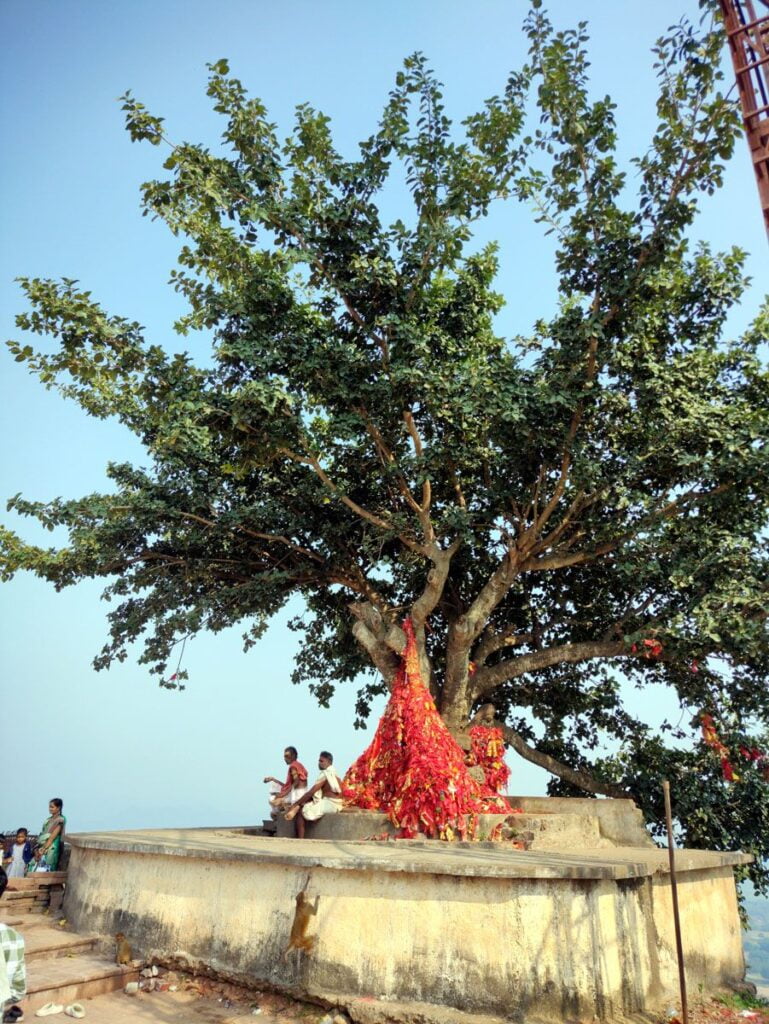
FAQ:
1. What is the significance of the Tara Tarini Temple?
- The Tara Tarini Temple is one of the most revered pilgrimage centers in India, dedicated to the Hindu goddess Tara Tarini, also known as the “Breast Shrine” (Sthana Peetha).
- It is one of the four major Shakti Peethas and Tantra Peethas in the country, believed to be the site where the left breast of Sati Devi fell when Lord Shiva carried her body across the universe.
- The temple holds immense religious and spiritual significance for Hindus, particularly followers of Shaktism, who seek blessings for health, wealth, prosperity, and fulfillment of desires.
2. Where is the Tara Tarini Temple located?
- The temple is situated atop the Kumari hills, on the banks of the Rushikulya River, near the town of Purushottampur in the Ganjam district of Odisha.
- It is roughly 28 kilometers from Brahmapur city and easily accessible by road.
3. What is the temple architecture like?
- The temple is built in the traditional Kalinga style of architecture, characterized by the use of red sandstone and intricate carvings.
- Unlike many other temples, it is located on a hill, offering breathtaking views of the surrounding landscape.
- The main sanctum houses two stone idols representing the twin manifestations of Tara Tarini, Tara and Tarini.
4. What are the timings and rituals at the temple?
- The temple is open daily from 4:00 AM to 9:00 PM.
- Several pujas and rituals are performed throughout the day, including the Mangala Aarti, Sandhya Aarti, and Tantric rituals.
- Special pujas are conducted on auspicious occasions like festivals and eclipses.
5. What are the facilities available for visitors?
- The temple complex has several amenities for pilgrims, including dharmsalas (pilgrim rest houses), cloakrooms, and refreshment stalls.
- A ropeway provides convenient access to the temple from the foothills.
6. What are some things to keep in mind while visiting the temple?
- Dress modestly and respectfully, covering your shoulders and knees.
- Photography is not allowed inside the main sanctum.
- Maintain silence and decorum within the temple premises.
- Shoes and slippers must be removed before entering the temple.
7. Are there any festivals or special events associated with the temple?
- Several festivals are celebrated at the Tara Tarini Temple throughout the year, including:
- Chaitra Mela (March-April)
- Chandayatra (March-April)
- Jhamu Yatra (April-May)
- Rath Yatra (June-July)
- Dasara (September-October)
- Diwali (October-November)
- These festivals attract large crowds of devotees from all over India.
8. What are some places to visit near the Tara Tarini Temple?
- There are several places of interest near the temple, including:
- Rushikulya Beach
- Khandagiri and Udayagiri Caves
- Nirmal Jharna Waterfall
- Chilika Lake
How to reach Tara Tarini Temple:
By Air:
- Nearest Airport: The nearest airport is Biju Patnaik International Airport (BBI) in Bhubaneswar, Odisha.
- Air Travel: You can book a flight to Bhubaneswar from major cities in India.
- From Bhubaneswar to Tara Tarini Temple: After reaching Bhubaneswar, you can hire a taxi or take a bus to Purushottampur, which is the nearest town to Tara Tarini Temple. From Purushottampur, you can proceed to the temple by local transportation.
By Train:
- Nearest Railway Station: The nearest major railway station is Berhampur Railway Station.
- Train Travel: You can take a train to Berhampur from various cities in India.
- From Berhampur to Tara Tarini Temple: After reaching Berhampur, you can hire a taxi or take a bus to Purushottampur and then proceed to the Tara Tarini Temple.
By Road:
- Road Travel: Purushottampur is well-connected by road. You can take a bus or hire a taxi from nearby cities like Berhampur or Bhubaneswar.
- Private Vehicles: If you are driving, you can use navigation apps or maps to reach Purushottampur. Once in Purushottampur, local transportation can be used to reach the temple.
